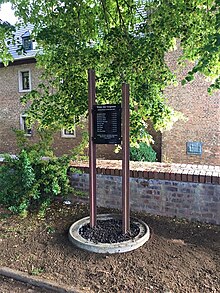Castle moat and park of Nörvenich Castle
The moat and park of Nörvenich Castle is located in the center of Nörvenich in the district of Düren , North Rhine-Westphalia on Bahnhofstrasse.
The western moat was lined with masonry in the 18th century. Until 1903/04 the wall was part of the water barrier.
The former park, the castle park, has a wall on the west side, which is popularly known as the Kockelsberg . This separates the school center from the park. The layout of the rooms and the structure of the building are unusually well preserved.
The complex was entered on April 22, 1985 in the list of monuments of the municipality of Nörvenich under No. 79.
traffic connection
The historic park around the castle can be reached via motorways and federal highways. In public transport there is a direct bus connection on the Düren circular railway from Düren to the monument with the Schlosspark stop in the center of the village.
History and Development
Today's green spaces have a long historical past. Settlement of the Nörvenich region goes back to Roman times with the founding of the city of Cologne and other settlements in the Roman sphere of influence at that time. A community-based use of the park and moat did not begin until the middle of the 20th century. At the end of the Second World War in 1945, the moat was still filled with water. During the later drainage, ammunition, bazookas and other weapons were fished from the swampy trench, which were thrown away while fleeing from the invading forces.
The deceased from the emergency hospital of the German Wehrmacht in the castle were buried close to where the primary school is today. The main cross (made of birch trunks) faced north-west.
204 transfers were made after the war by the Karl Klaus company from Wesel. The dead were taken to the cemeteries of honor in Huertgen and Rurberg. The reburial was completed in September 1950.
Public and cultural use
By taking over the green areas of the historic palace complex, the municipality of Nörvenich has created the prerequisites for a citizen-friendly town center with children's playgrounds and a recreation area. For decades, the center of the community park has been a war memorial, which the sculptor Ulrich Rückriem, who lived in Nörvenich at the time, carved out of red sandstone in the form of a flame.
From 1980, the castle family Marie-Louise and JF Bodenstein designed the moat for open-air exhibitions. After early installations by the sculptor Rückriem, classical and modern art of national interest will be presented in alternating succession. The themed exhibitions included “In the Garden of the Gods” with works by Arno Breker and “The Female Nude!” With exhibits by Western European artists. Since 2013, plastic works by Kurt Arentz , Peter Hohberger , Arno Breker, Auguste Rodin , Renate Stendar-Feuerbaum, Karolin Donst , Siegfried W. Lunau , Günter Thelen , Detlef Krebs , Irenee Duriez (Belgium) and others have been part of the open-air exhibition The cultural center's air exhibition is complemented by interior exhibits from the other cultural institutions with works by Andy Warhol , Rainer Arke , Salvador Dalí , John Marcó, Ernst Fuchs , Birgit Sewekow , Lajos Tar , Maria Geroldine Dörpinghaus (SND), Elke Seimetz and other contemporary artists .
Nörvenich memorial
The Nörvenich memorial is in the castle park. In the community of Nörvenich there were only two places where Jews lived, namely in the central town itself and in Hochkirchen . The closest synagogue was in Lüxheim (see Synagogue Lüxheim ), where there is still a Jewish cemetery . The Schwarz / Treu and Hermanns families were all deported until 1942, first to the Düren collective accommodation facilities and from there to the concentration camps . At the war memorial in the castle park there has been a plaque in Hebrew script since 1983 in memory of the killed Jews. The homeland and history association of the municipality of Nörvenich e. V. had thought of a Jewish girl named Marianne Hermanns in an event in Nörvenich Castle on November 16, 2008 . Subsequently, a memorial designed by the local history association was inaugurated in the castle park . The names of the Jewish fellow citizens are burned out on a black metal plaque. This plaque hangs between two railroad tracks, symbolizing the transport by train to the warehouse. The location of the memorial is symbolically chosen, because opposite the memorial at the address Burgstrasse 14 was the residential and commercial building of the Hermanns family.
The memorial was moved to the surrounding wall of the moat on June 17, 2020 due to the expansion of the Burgstrasse.
supporting documents
- List of monuments of the municipality of Nörvenich (PDF; 108 kB)
Individual evidence
- ↑ http://www.meaus.com/0202-soldaten-friedhof.htm .
- ^ Editions Hirlé, Paris, Art-Book, "Arno Breker Sculpteur" ISBN 978-2-914729-83-3 .
- ^ Arentz catalog, Museum Edition 1993, ISBN 3-925176-07-1 .
- ↑ B.John Zavrel, "paintings and sculptures," Museum of European Art. USA, ISBN 0-914301-18-7 .
- ^ Herbert Pelzer: A new memorial plaque in the Nörvenich castle park . In: Yearbook District Düren 2011, pp. 13-15, ISBN 978-3-942513-00-5
Web links
literature
- Henk Verbeek: “Land an der Rur”, architectural monuments and European history along the Rur river in Belgium, Germany and the Netherlands; 2014 edition "Kunststrom Rur" municipality Roerdalen NL.
Coordinates: 50 ° 48 ′ 29.5 " N , 6 ° 38 ′ 41.7" E




